RIGHT TURN ONLY!!
Alice in the Country of Ninjas
by Carlo Santos,

Another Anime Expo has come and gone, and with it, another batch of once-in-a-lifetime memories.
Things I have learned from going to conventions over the years:
- Wear comfortable walking shoes.
- When you're tired, rest. When you're hungry, eat. There is nothing to be gained by physically destroying yourself.
- If there is an event you really REALLY want to go to, get up insanely early and line up, because chances are everyone really REALLY wants to go to it too.
- During T-shirt throws, wait for one to come right at you, and then SMOTHER it.
- Wash.
- Believe in yourself, pierce the heavens, do what must be done, and you CAN make amazing things happen.
ALICE IN THE COUNTRY OF HEARTS
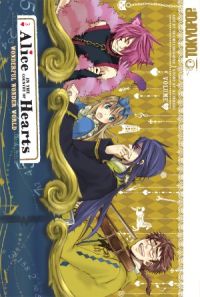
Vol. 3
(by Quinrose X Soumei Hoshino, Tokyopop, $10.99)
FROM THE BACK COVER:
"Alice's comfort level in Wonderland continues to grow. But something very strange is happening. Confusion, memory loss and sudden pain become associated with thoughts of home. Meanwhile, Peter cunningly finds a way into Alice's bedroom, and Vivaldi reveals a peculiar secret! And what will Alice do when she is suddenly attacked by Blood Dupre?!"
EVIDENCE FOR:
Goodness, did I just feel a twinge of moe for Peter the White Rabbit when he tried to win over Alice's heart? Yes, it seems that the characters really do grow more endearing over time in this bishounen-infused take on Lewis Carroll's classic book. Most of the guys in the story are still jerks in some way or another, yet it's those personality flaws that make them alluring: Julius the clockmaker's quiet overprotectiveness, Ace's free-swinging blade, the ruthlessness of Blood (the Mad Hatter), and yes, even Peter's beta-male desperation. More than just the delicious harem of males, though, it's the dark and deviant side of Wonderland that will keep readers hooked: the Queen of Hearts's private audience with Alice is not what one may have expected from a prim and proper royal, and the declaration of war in the final chapter is the biggest shake-up yet in the storyline. As always, the cleanly drawn character designs and uncluttered layouts maintain the series' high level of visual appeal—the perfect manifestation of shoujo style without resorting to the cheap gimmicks that often come with it.
EVIDENCE AGAINST:
Maybe a few cheap gimmicks wouldn't be such a bad idea—considering that a lot of what goes on in this volume is downright boring. Let's see, at the beginning Peter tries to put the moves on Alice, at the end some of the main characters pull guns on each other, and in the middle there's ... what? Absolutely nothing! Well, there's lots and lots of talking, but talk is cheap, and by about the twentieth page of Julius and friends shooting the breeze about how mysterious Alice is and how everyone loves her, no one cares anymore. In between there are also flashback scenes showing Alice's memories of her real life, and apparently they're supposed to be in danger of disappearing or something, but the sense of peril never really comes through. In essence, they become flashbacks for the sake of flashbacks. So aside from that declaration of war, the entire rest of this volume is about Alice having various interacttions with the denizens of Wonderland ... you know, just like the game this manga is based on. Except less interactive. Welcome to Alice in Slumberland.
FINAL VERDICT:
If it weren't for the appealing art and occasionally amusing characters, this plot-impaired snoozefest would be in danger of falling even lower than a C-.
AX: A COLLECTION OF ALTERNATIVE MANGA
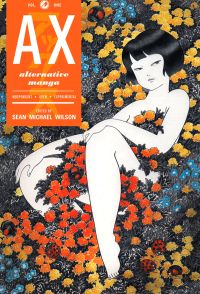
Vol. 1
(edited by Sean Michael Wilson, Top Shelf, $29.95)
FROM THE BACK COVER:
"Ax is the premier Japanese magazine for alternative comics. Published bi-monthly since 1998, the pages of Ax contain the most innovative, experimental, and personal works in contemporary manga—the flourishing underground of the world's largest comics industry. Now Top Shelf presents a 400-
page collection of stories from ten years of Ax history, translated into English for the first time!
This landmark volume includes work by 33 artists, including Yoshihiro Tatsumi (A Drifting Life), Imiri Sakabashira (The Box Man), Kazuichi Hanawa (Doing Time), Akino Kondoh, Shin'ichi Abe, and many more! It's a feast of pure creativity, and a guided tour of fascinating new directions in Japanese comics."
EVIDENCE FOR:
If anyone thought I had sold out and succumbed to reading teen-oriented trash all day, you are wrong, good sir or madam. Ax adds the necessary exotic flavors to every reader's diet, with its astounding variety of styles (anything from stick-figure art to stylized near-realism) and stories (fables, documentaries, slices of life, and pure abstraction). Some of the best selections are the ones with a clever final twist: a tortoise-and-hare rematch inspired by Aesop; a tragicomic tale of a woman who gives birth to puppies; a suicidal office worker who crosses paths with a hitman; a mushroom collector whose garden gets out of hand. Meanwhile, some of the other stories only reveal their true brilliance over the course of many pages—like a winding tale about a boutique motorcycle manufacturer from Brazil, or a feudal sci-fi horror story (who would have thought those three genres could all show up in the same place?) about a bizarre ant-worshipping cult. Even the historical dimension is covered, with grand old masters like Yoshihiro Tatsumi contributing. You know how pundits always say that manga is great because it has something for everyone? This is the book that actually proves it.
EVIDENCE AGAINST:
You know how manga pundits are a bunch of stuck-up bookworms who blindly hate anything that's popular while worshipping badly-drawn, plotless nonsense? This is also the book that proves it. The kind of artists that get into Ax are clearly the ones who couldn't hold a serialized storyline to save their lives, as proven by the number of entries where the art is "really pretty and unique" but what actually happened is anyone's guess. This problem is further compounded by long, pseudo-philosophical paragraphs that are perhaps meant to add emotional impact, but read more like Evanescence lyrics translated into Japanese then back into English. Fortunately, only a few of the stories are like that. The other misfires simply suffer from too much art-school philosophizing: the madness of modern society, sexual frustration and deviancy, and the incomparable loneliness of the human soul. If this is supposed to be "alternative," then how come they always do the same topics over and over? It's one thing to have an artistic idea, but not every artist can execute it well.
FINAL VERDICT:
No anthology is perfect, but fortunately, this one's hits outweigh the misses. Those seeking something new, fresh and amazing will be glad to know that Ax scores an A- in originality.
NARUTO
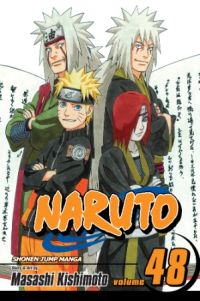
Vol. 48
(by Masashi Kishimoto, Viz Media, $9.99)
FROM THE BACK COVER:
"Naruto is a young shinobi with an incorrigible knack for mischief. He's got a wild sense of humor, but Naruto is completely serious about his mission to be the world's greatest ninja!
Finally face-to-face with his ultimate nemesis, Naruto finds out there's more to the true Pain than he could have ever imagined. As the consequences of the tumultuous politics of the past come to light, an unexpected turn of events puts a new ninja in power in Konoha. And the first act by the new leader will change Naruto's world forever."
EVIDENCE FOR:
Pain may not be the greatest villain in Naruto history—personally, I think certain members of the Uchiha clan outclass him—but no other adversary so closely mirrors Naruto's own upbringing. For that reason, this volume turns out even more profound than the last one: a second examination of Naruto's conscience, this time through the twisted lens of Pain's childhood. Even more remarkable is how Naruto ultimately triumphs over Pain—not through sheer firepower or jutsu trickery, but through empathy and emotional force of will. Seriously, next time someone dismisses all shounen as brainless, never-ending slugfests, just show them the middle chapters of this volume. Even Naruto's heroic homecoming is charged with a certain poignancy, a moment that looks inward to his fragile heart as much as it does to the outward cheers of the crowd. But lest things get too touchy-feely, the sudden shift of power in the later chapters reminds us that there's still plenty of drama to come. The level of detail in the visuals also continues to impress, whether it be through high-speed ninja moves, meticulously sketched landscapes, or the incredible variety of characters—each one integral to the plot.
EVIDENCE AGAINST:
Oh, for goodness sakes. Did Masashi Kishimoto really just pull the oldest trick in the epic-adventure book? Did he seriously hit a reset button just now? Naruto's battle against Pain may be unconventional by shounen standards, but the aftermath is pure cliché—the kind of twist that will have readers banging their heads against the nearest hard object. The events leading up to it are also sloppy in their execution, with lots of crisscrossing flashbacks (Pain's childhood? Naruto's childhood? Jiraiya?) and too much talking. With a story as complex as this, of course it's necessary to explain certain things, but Pain's droning narration turns several pages into walls of text, with only Naruto's rebuttals and Jiraiya's words of wisdom to break up the monotony. Then comes the next story arc, where a new Hokage takes power and Sasuke tries to get himself back into the story, but it just seems to take forever for that plotline to take off. They spend a good 40 pages talking about the Akatsuki's next move and the importance of the Gokage Summit—so why don't the guys just go there already?
FINAL VERDICT:
It has some good, deep moments, as well as a great triumph for the main character, but the excessive dialogue and downslide in action spell a B- for this volume.
TSUBASA

Vol. 26
(by CLAMP, Del Rey, $10.99)
FROM THE BACK COVER:
"Seconds before Sakura's imminent death, Syaoran made a wish and managed to turn back time. But now time has returned to that exact moment, and the obsessed Fei-Wang will not allow Syaoran to undo his twisted plots and evil plans again. If Fei-Wang wins, Sakura will die. The final battle begins!"
EVIDENCE FOR:
How's this for a shocking revelation? The most important plot point to be revealed in this volume of Tsubasa ... is actually all about xxxHOLiC. The fairytale flashback that explained Sakura and Syaoran's origins last time takes a sudden left turn in this installment, with mind-bending feats of time-travel, metaphysics, and maybe some ethically questionable cloning. What it all adds up to is a bombshell so big that it doesn't just impact the storyline of one but two CLAMP titles. Then there is the inevitable battle that ensues, with Fei-Wang Reed finally showing his face in person (!!!) and Syaoran going toe-to-toe with his evil lookalike. It's just like the Tokyo incident from way back when—only more epic. The incomparable artwork also helps to make this battle look bigger and badder than anything that's come before: gusts of wind, bolts of lightning, and tongues of flame reaching across multiple pages; fantastical landscapes being blown apart; and linework so raw and powerful that you can almost feel the book shaking. And then, in the last few chapters—a payoff so incredible, so dramatic, that one can only wonder how Vol. 27 is going to top this one.
EVIDENCE AGAINST:
Perhaps, in its quest to become the ultimate universe-spanning adventure OF ALL TIME, Tsubasa has topped itself—and is now in danger of completely falling over. Just look at the ridiculous time-travel segment in the first two chapters, which is clearly trying to explain something important about the Tsubasa/xxxHOLiC connection—except that there are quantum physics papers less complicated than this. This is a boys' adventure series; one should not need a Ph.D. to understand one of its fundamental plot points. Of course, much of the blame lies in the dialogue, which is even more vague and infuriating than usual—lots of talk about wishes and memories and whatever else CLAMP can spit out on paper. Fortunately, when the characters start fighting, they stop talking—but the fight is nothing particularly unique; it may look like a watershed moment for the series simply because the special effects have been turned up all the way, but once again it's just brute magical force vs. brute magical force. And how about that utterly predictable twist ending between Syaoran, his clone, and Fei-Wang Reed? Somehow, even the clichés in this series are epic.
FINAL VERDICT:
Another heavy dose of plot revelations and spectacular combat as the series' final arc enters full swing—but all that convoluted magical theory tempers it down to a B.
TWIN SPICA

Vol. 2
(by Kou Yaginuma, Vertical, $10.95)
FROM THE BACK COVER:
"Admitted to the prestigious Tokyo Space School, Asumi appears to be on track to make her dreams come true. However, enrollment was just the first of many trials she must overcome on her path to the stars."
EVIDENCE FOR:
Just like in the first volume, Twin Spica continues to defy expectations by being all about the quest for space ... and then having zero scenes of giant robot piloting or super galactic combat. Instead, the battles in this series are fought between the characters' conflicting personalities—or even within their own souls. Much of this volume's friction comes from stuck-up ice queen Marika, who provides the ideal counterpoint to Asumi's do-your-best attitude, and keeps the story from descending into an endless grind of training exercises. Even those on Asumi's side provide various ups and downs on the friendship rollercoaster, whether it's getting into a tiff with her best friend or having to deal with boys being boys. It's in the side-story chapters, though, that the real heart and soul of Twin Spica manifests itself: the profound feelings that come from having to cope with loss, the way one's character is strengthened through grief, and the remarkably perceptive eyes of a child. That Kou Yaginuma is able to express such depths of emotion through his simple, gentle linework and no-nonsense layouts is a true sign of artistic skill: no starships, no lasers, just a vision of humanity facing an uncertain future.
EVIDENCE AGAINST:
After the incredible displays of human willpower and inner strength in the first volume, this one feels ... well, a lot less incredible. Where we once had pubescent heroes and heroines solving brain-melting puzzles and surviving closed-room tests, we now have a completely ordinary exercise in classroom drama. Honestly, take away the space theme and it might as well be one of ten billion other school-themed manga series where the new girl in town tries to make friends with everyone while seeking her place in the world. Oh, and of course the stereotypical rich bitch is standing in the way of her happiness wherever she goes. Seriously, did Yaginuma's brain suddenly get struck by stupid waves after the first few chapters and he suddenly decided to do a generic school melodrama instead of a sci-fi/slice-of-life masterpiece? Plus, what is with the side stories (which were authored prior to the main series) always taking up so much space? Sure, they're very good chapters, and fill in some vital background information, but the main story is suffering as a result. We're already two volumes in and Asumi's barely made any progress—just like real space-exploration bureaucracy, apparently.
FINAL VERDICT:
Hate to say it, but this is a significant drop-off from the first volume. The sudden shift to typical school drama (albeit with some touching moments) nets this a B- grade.

BIZENGHAST
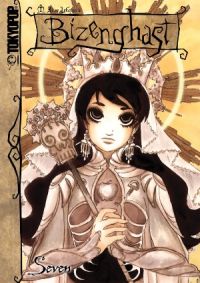
Vol. 7
(by M. Alice LeGrow, Tokyopop, $10.99)
FROM THE BACK COVER:
"An epic battle rages for the lives and souls of the inhabitants of Bizenghast, and no one is safe anymore. Shocking revelations of the town's dark history continue to emerge, and Dinah's struggle will go beyond the borders of the mausoleum, and possibly beyond Bizenghast itself..."
EVIDENCE FOR:
It's been a long road for Bizenghast, which years ago started out as an overhyped piece of Hot Topic claptrap, but has since matured into a legitimate work of supernatural fantasy. This volume has everything that makes otherworldly adventures great: the humble heroine stepping into her destiny, the unbeatable bad guy stripping away any possibility of hope, and—at the last moment—a dramatic turnaround that could be the ultimate make-or-break for Dinah. In between there's even a chilling flashback, narrated in LeGrow's unmistakable dark-fairytale style. This is a world full of magic and wonder, the kind that pulls in curious visitors ... and then scares the pants off them. Much of that charismatic pull comes from the artwork, which—like the author and the story—has matured over the years, developing into an intricate style that owes as much to Edward Gorey and Charles Addams as it does to the likes of Kaori Yuki. The towering architecture, atmospheric backgrounds, elaborate costumes, and painstaking hand-drawn shading all add up to a world that is unlike any other. Even LeGrow's layout choices, which allow plenty of room for the images to breathe, create an utterly unique visual flavor.
EVIDENCE AGAINST:
All right, so the linework's a bit more steady and the action has its "wow" moments, but after finishing this volume, one gets a certain feeling of emptiness. The emptiness of a story arc that is exactly like all other story arcs about heroes and heroines facing their destiny. The emptiness of a villain whose plot to turn all the good guys bad just happens with a snap of a fingers, no twists or complexities necessary. The emptiness of Dinah's "final transformation," which is completely predictable (from a storyline perspective) and completely laughable (from a visual design perspective). Hey, if you're going to put on some amazing badass armor for the final battle, at least make it look cool. Ultimately, it's as if someone just laid out some prefabricated plot points for each section of the book, and had an artist blindly fill it in with as many pretty buildings and scary creatures as possible. And even then, one sees moments of sloppiness like hatch lines going crooked or facial features slightly off-center. Bizenghast may be a beautiful otherworld, but there's something clearly fake about it.
FINAL VERDICT:
Oh, if only they taught how to write real stories at comic school, with actual depth and complexity! This one's great on style, but clearly falls short on substance.

Come on folks, more reviews! I need 'em, please! With the current industry downturn, we need all the suggestions we can get, to help the market survive. Send in your 300-400 word reviews to rtoreaders(at)gmail.com!
Speaking of the downturn, this week we take a walk down memory lane by looking at a release from the now-defunct Go! Comi. From the archives, here's a review by Hikari about the very thought-provoking After School Nightmare:
AFTER SCHOOL NIGHTMARE
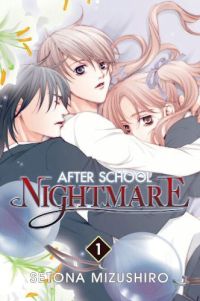
(by Setona Mizushiro, Go! Comi, $10.99 ea.)
What do you do if you want something thoughtful, provocative, and engrossing to read without a relying on violence or sex to tell the story? You pick up After School Nightmare (ASN), written by Setona Mizushiro, the same woman who penned the controversial [Shounen-tachi no] X Day.
Mashiro is not your typical bishounen high school aged lead character. For one thing, he doesn't have male genitalia. He's a hermaphrodite, and totally embarrassed about it. It doesn't help that he has both a female classmate and a male classmate interested in him. More pressing, this weird teacher tells him he has to complete special after school classes in the infirmary to graduate. Poor Mashiro discovers that the high school he attends is just a facade, and the real graduation exam is the dream world he has to fight in to conquer his inner trauma amongst other classmates' inner beings as well, find the key, and open a new door. If it sounds totally cheesy and ripe for sucky love triangles, you'd normally be right, but Mizushiro has managed to handle it in a completely refreshing and shocking way. The yaoi fangirls want to cheer for the male-male couple, but then you remember...wait, one of them is only half a man. Now what? You want to root for the three main characters to work out their romantic issues, but you also want them to find their keys and graduate. What's on the other side of the dreams? Mizushiro also rotates in new characters (and out when they graduate), and later brings reoccurring ones into the spotlight, so it keeps the dual storylines from getting repetitive. Each volume is an utter cliffhanger.
The art is drawn with solid lines; it lacks a bit in detail and in some places appears a bit flat. A bit more background art wouldn't hurt. However, it is in the splash pages that the manga-ka's talent really shines. She has a flair for creative scenery for the dream scapes, drawing gothic style clothing, and realistic looking people with distinguishable facial expressions. There's even a giraffe in this manga and it looks pretty real too! There's no chibifying or anger marks or sparkly eyes or panty shots, which would only cheapen it.
I'm so engrossed with this series, it's really lovely to see manga handle sexual issues (like hermaphrodites getting their periods) without dousing it with perversion, dirty jokes, and unrealistic uke/seme stereotypes. If you liked Confidential Confessions, or work by manga-ka like Sumeka Yumomo, you'll probably enjoy this too.
Is there a hidden gem of manga you'd like to reveal to the world? Is there a piece of garbage that deserves to be bashed in public? Or is there a title that didn't get a fair grade here, and you want to set the record straight?
Now's YOUR chance to be the reviewer! Write a review of about 300-400 words (a little more or less is fine) and include:
- Your name
- Title of manga (and volume no., if applicable)
- Author/Artist
- Publisher
- Briefly describe the story, then explain why this manga is great, terrible, or in between. Be objective, but also be entertaining.
Then send it in to rtoreaders (at) gmail (dot) com (plain text format preferred). One review will be selected out of all the submissions and will be published in the next column. All types of manga and manga-inspired comickry are accepted, from past and present, from Japan and beyond—what matters is that it's the Reader's Choice! NOTE: Submissions may be edited for formatting and grammar.
discuss this in the forum (18 posts) |